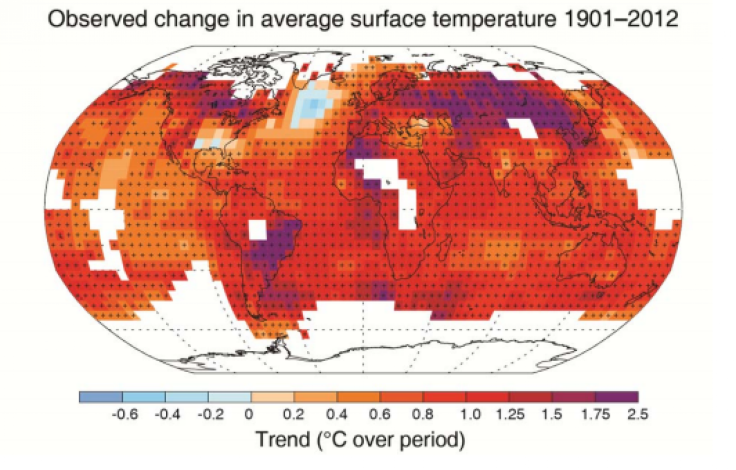Global Warming Report Released: IPCC 95% Sure Humans Primarily Responsible For Recent Climate Change

A United Nations panel is now 95 percent sure humans are the primary cause of climate change in the past half-century.
On Friday, the Intergovernmental Panel on Climate Change released the first part of its Fifth Assessment Report, the Summary for Policymakers [PDF]. More than 600 authors from 39 countries analyzed more than 9,000 peer-reviewed scientific papers in their analysis, plus 54,000 comments. A final draft of the IPCC’s full report will be available online on Monday, 30 September, while a finalized version will be published online in January 2014. The results strike a familiar tone: Arctic ice is shrinking, the climate is warming all across the globe, and these trends will continue if humanity does not act.
“Warming of the climate system is unequivocal, and since the 1950s, many of the observed changes are unprecedented over decades to millennia,” the IPCC report said. “In the Northern Hemisphere, 1983–2012 was likely the warmest 30-year period of the last 1400 years.”
From 1880 to 2012, the average land and ocean surface temperature has increased by .85 degrees Celsius (1.5 degrees Fahrenheit). The report notes that the rate of warming over the past 15 years -- .05 degrees Celsius from 1998 to 2012 -- is smaller than the rate of warming seen from 1951 to 2012.
“The climate change denialists will try to misrepresent the recent, 15-year slowdown in atmospheric warming as evidence that scientists and the IPCC overestimated the effects of anthropogenic greenhouse warming,” Cornell University earth and atmospheric scientist Charles Greene said in an emailed statement.
Earth's climate system is still warming just as rapidly as it was before the “hiatus,” Greene says. But the difference is that, compared to the warming seen in the 1980s and 1990s, a greater amount of the extra heat is accumulating in the ocean instead of the atmosphere.
“It is important to remember that over 90 percent of the anthropogenic greenhouse warming to date is stored as excess heat in the ocean,” Greene says. “If that were not the case, then we would be would have experienced a much greater rise in global mean atmospheric temperature than has been observed to date.”
Based on recent observations, the IPCC is revising its estimation of what’s called “climate sensitivity,” the measure of how much warming results from a doubling of carbon dioxide concentrations in the atmosphere. In 2007, the IPCC pegged the range of climate sensitivity at between 2 - 4.5 degrees Celsius; in the new report, the panel estimates that doubling of the CO2 concentrations in the Earth’s atmosphere will result in a warming between 1.5 to 4.5 degrees Celsius (2.7 to 8.1 degrees Fahrenheit).
Several years ago, scientists and policy makers set a goal of limiting global warming to less than 2 degrees Celsius (3.6 degrees Fahrenheit). Many researchers say that even that limit is too high. The current global warming of less than one degree is already manifesting in ecosystems across the globe. Climate change-related droughts in the western U.S. have been linked to outbreaks of bark beetles that are killing large numbers of coniferous forest trees. Ocean acidification is threatening shellfish and coral reefs across the globe.
“At essentially double [the] current temperature increase, there undoubtedly will be massive extinctions and widespread ecosystem collapse,” Thomas E. Lovejoy, a professor of science and public policy at George Mason University, wrote in a New York Times op-ed in January.
At what point will we reach some climate “tipping point” that leads to widespread catastrophe? Pennsylvania State University climate scientist Michael Mann says the problem is that we don’t know exactly where the point of no return is.
“It’s sort of like the blind man who knows he's approaching a cliff, but doesn't know how far away it is,” Mann wrote in an email. “The only safe strategy: stop moving toward the cliff.”
Eileen Claussen, president of the Center for Climate and Energy Solutions, says that the businesses her organization works with are increasingly aware of the risks posed by climate change. C2ES recently surveyed the S&P Global 100 companies, and found that 90 percent saw climate change and extreme weather as present or near-term business risks.
Businesses “worry about closed factories, loss of power or water, disruption of supply and distribution chains, and rising commodity and insurance costs,” Claussen said in a statement. “Many companies are taking steps to strengthen their climate resilience and investing in a low-carbon future.”
© Copyright IBTimes 2024. All rights reserved.











